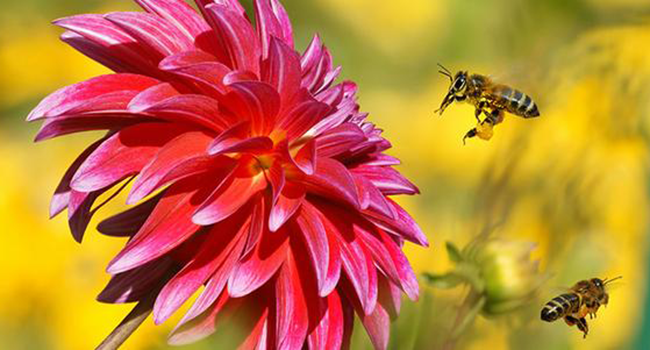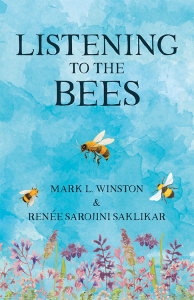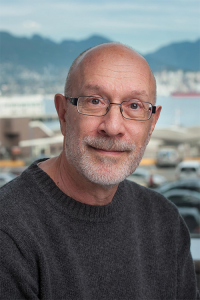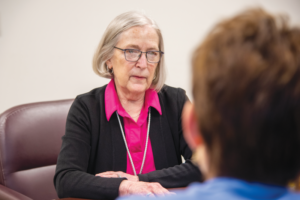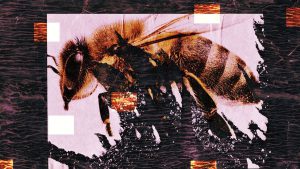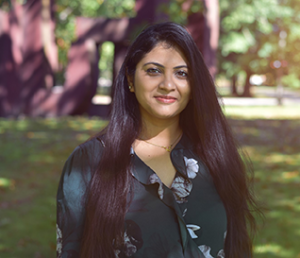By: Mark Winston
I’ve learned quite a bit from bees, lessons around the value of collaboration, clear communication, a strong work ethic and social responsibility. But I’ve learned as much from the people I met through the bees as I did from the bees themselves.
My first encounter when I moved to BC in 1980 was John Corner, the Provincial Apiarist from 1950 to 1983. John was born in Ladysmith, a small town in BC built around the logging industry. His family soon moved to the remote Kootenay Mountains where he grew up hiking and canoeing in the surrounding wilderness.
John began his lifelong interest in bees as a 12-year-old working for a local beekeeper. His passion for bees continued to develop during the Second World War while fighting in Belgium. He was a decorated hero, receiving the Order of the British Empire for gallantry, but rarely discussed his combat experiences. He did often mention that he studied beekeeping as a distraction from the war around him, developing a habit of reading voraciously that he continued throughout his life. John had no formal education beyond high school, yet was one of the most educated and scholarly individuals I’ve known. Self-taught, he became an expert in Aboriginal rock paintings, consulted by experts worldwide about the BC pictographs that he meticulously documented. His book Pictographs (Indian Rock Paintings) in the Interior of British Columbia remains a classic and much-cited work, detailing hundreds of pictographs that he recorded over decades of travel throughout the province.
- Mark Winston, SFU photo.
His impact on beekeeping in British Columbia was immense, a major factor in expanding what had been a hobby and sideline endeavour into a commercial industry. Most notably, he conceived and led a project to breed queen bees for BC, collaborating with esteemed researchers globally to design and implement the project. Honey bees have an odd genetic system and breeding bees is one of the more difficult tasks in animal husbandry, yet John and his team studied the subject intensively and worked through the complex genetics to produce reliable lines of bees. Those queens were among the best I’ve seen and many of the individuals working on the project became commercial breeders still influential in the BC beekeeping scene.
John Corner kindly took me under his wing when I first arrived in British Columbia. I was equipped with a fair bit of academic knowledge but little experience relating to beekeepers. We travelled the province together for many years, visiting individual beekeepers and attending meetings, providing a unique opportunity for me to observe and learn from John about how to interact with often-quirky beekeepers. John was the quintessential gentleman, as gracious when chatting with servers in the many small-town restaurants at which we shared meals as he was talking with dignitaries. He was an appreciator, curious about the lives and stories of everyone he met. He had mastered the art of being quiet but attentive, sparse in responding but resonating with thoughtfulness and kindness when he did.
John’s listening skills made him an insightful judge of people, but he wasn’t judgmental, just perceptive. This skill yielded excellent choices in those he hired, sometimes after just chatting for a few minutes, and many of the individuals he mentored are still leading figures in beekeeping. I don’t recall John ever directly instructing me, or anyone else, about how to be, but I know I absorbed important lessons through spending time in his orbit. I came to appreciate the power of listening, the importance of curiosity and the value in building relationships with those from different backgrounds and perspectives than my own. The beekeeping world served up a rich source of friends and colleagues, largely because I followed John Corner’s example.
He also inspired me to apply the thoroughness of basic academic research to applied questions. John’s approach to bee research combined extensive combing of literature, careful listening to the practical experiences of beekeepers, meticulous experimental design, a high regard for replication through large sample sizes and conducting experiments over multiple years and in diverse locales. Our research on package bees, pollination, swarm prevention, pest management and other practical research topics in my laboratory benefited greatly from John’s example. Due in a large part to his influence, my laboratory became known for our careful attention to practical problems.
Cam Jay, a professor at the University of Manitoba, also became a close friend and an important role model. He, too, was the most careful of researchers, equally esteemed by the research community and beekeepers, but what he taught me by example was that work was not the primary goal of existence.
Cam developed a pursuit that gave him precious time alone but also provided opportunities to visit with his many friends across the prairies. He was a pilot who loved to fly, rebuilding a 1949 airplane that he kept in a hangar on property he owned outside of Winnipeg with a grass runway. He had quite a reputation for swooping down and landing unannounced at beekeepers’ homes, on whatever pasture could serve as a landing site. He’d drop in, visit for a bit, and then head off to another unexpected stop. He was particularly renowned for winter flying, when he would land on a frozen lake populated by ice fishing cabins, knock on a door with an empty pizza box he kept in his cockpit, and ask the fishermen whether someone there had ordered a pizza. He was invariably invited in for a chat, a drink and some fishing time before taking off to fly back home.
Cam was a kid at heart, hardworking but also fun-loving. His home was covered with photos of special family events, friends and travels, but it was only in his home office that his numerous awards, plaques and honours were displayed. He told me once that he kept them privately rather than at his university office because he didn’t want people to think more highly of him just because he had received some awards.
One of my great regrets is that I never had the chance to fly with Cam, but we did have two other traditions. I mentioned to him once that I was a serious pie aficionado, and from that day on there was always a fresh pie waiting for my Winnipeg visits, baked by his wife Doreen. Cam was reserved about many things but his love for Doreen was highly public. He was known as the “Billboard Romeo” in Winnipeg because every 10 years, around their wedding anniversary, he purchased a large billboard advertisement to proclaim his lasting devotion.
I saw Cam often at conferences, where we exercised our second tradition. We’d sneak away from meetings to seek out the best local milkshake, as shakes were almost as compelling for Cam as flying. The pies at home and the milkshakes away were mostly a convenient excuse to talk, and here I benefited from Cam’s considerable wisdom about how to live a life. There was much contentment in Cam’s life, but also sorrow, as there is for all of us. His infectious laugh provided a wonderful lesson that, as difficult as life can be, it can also be replete with joy and love.
Like John Corner he was never too obvious with direct advice, but nevertheless would provide gentle caution when he saw that perhaps I was taking myself too seriously. Academia is a profession in which overwork is rampant, and ego abounds. I so valued Cam’s example of a different work-life balance than I saw in many of my colleagues, and learned from our time together that there were things in life more important than the job. Work hard but always with a sense of fun, love your family and enjoy your friends – these were the core guiding lights for Cam, messages that I very much needed to hear as a young faculty member tempted to overwork.
Eva Crane was the opposite of both John and Cam, although close friends with them both. She was direct with advice where they were roundabout, pointed where they were subtle. Our first encounter was more of a wrestling match without a referee than a small talk getting-to-know-you session. Eva was quintessentially British, and in looks and demeanour could easily have doubled for the Queen. Born in 1912, she earned a Ph.D. in nuclear physics in 1941, an unusual achievement for a woman of her era. She married shortly after, and she and her husband were given a beehive as a wedding present to supplement their Second World War sugar ration.
Her passion for bees soon won out over nuclear physics, and in 1949 she abandoned that career and started an organization that eventually became the International Bee Research Association. In that capacity she edited their journals, wrote 180 articles and many voluminous, comprehensive and seminal books about honey, beekeeping and the archaeology of bees, mostly while in her seventies and eighties. One of her books, on the rock art of honey hunters, reflected a joint interest in pictographs she shared with John Corner.
Our first meeting was in my office at Simon Fraser University shortly after I’d arrived in 1980, and it turned into a tussle, albeit an enjoyable one. We’d barely said hello when she insisted that we find a larger room with a long table at which to work. She was carrying a manuscript I had submitted to the publication she edited, the Journal of Apicultural Research, and she didn’t want to waste a moment before getting down to fixing my writing errors. We got to work and spent most of an afternoon reading through the manuscript word by word, arguing over what I thought were the most minor of changes. At first I was taken aback, then perhaps a bit defensive, but by the end of the day I had to admit how much I’d enjoyed myself.
Eva was my first serious editor, and through her I came to appreciate the importance of exact language and the power of focus in writing. Words mattered to Eva, not only in themselves but because bees matter, and anything that matters deserves the most rigorous attention to the highest standards of precision, clarity and nuance that language can provide.
John, Cam and Eva all passed away within three years of each other: Eva in 2007, Cam in 2008 and John in 2010. I felt the loss of each of them deeply, partly because they represented a rich era in bee science and beekeeping, but also because each had graced me with models for how I, too, might grow. From John Corner I learned to listen and to treasure the great diversity in personalities and attitudes revealed when we approach others with curiosity rather than judgment. Through Cam I grew to be a more balanced person, becoming more focused and effective at work as I learned to relax at home. Eva reminded me of the thrill in a well-turned phrase and the joy in finding just the right words (but not too many), igniting a passion for language that is still among my greatest delights.
As I age I am beginning to understand that a common phrase we use for those who have passed on is more than just a cliché. John, Cam and Eva: for me, you may be gone but you are truly not forgotten.




